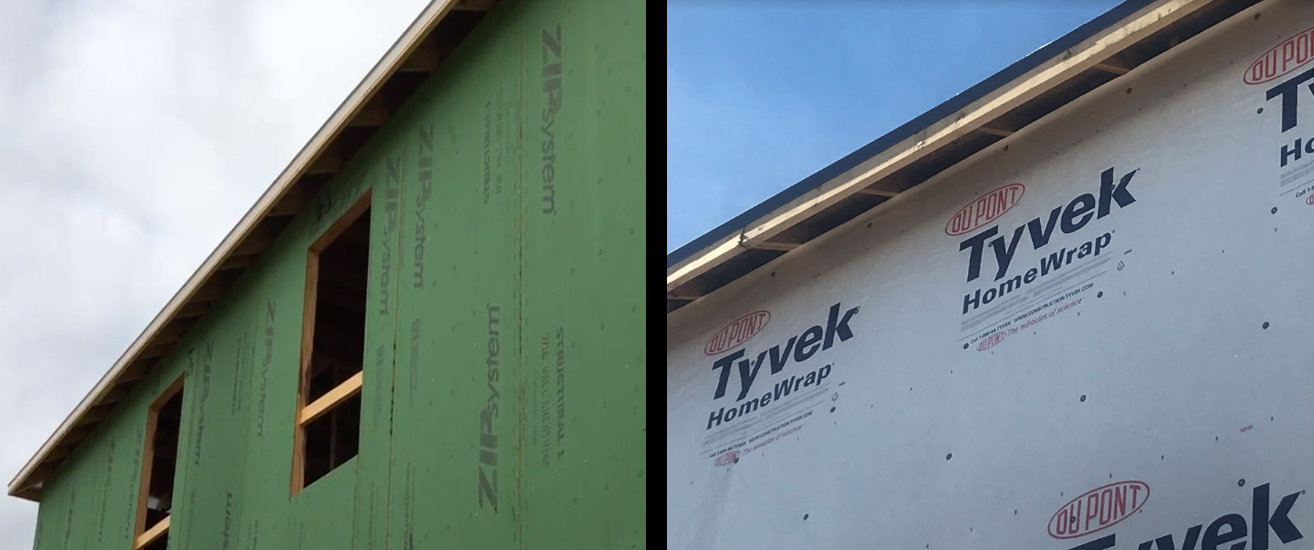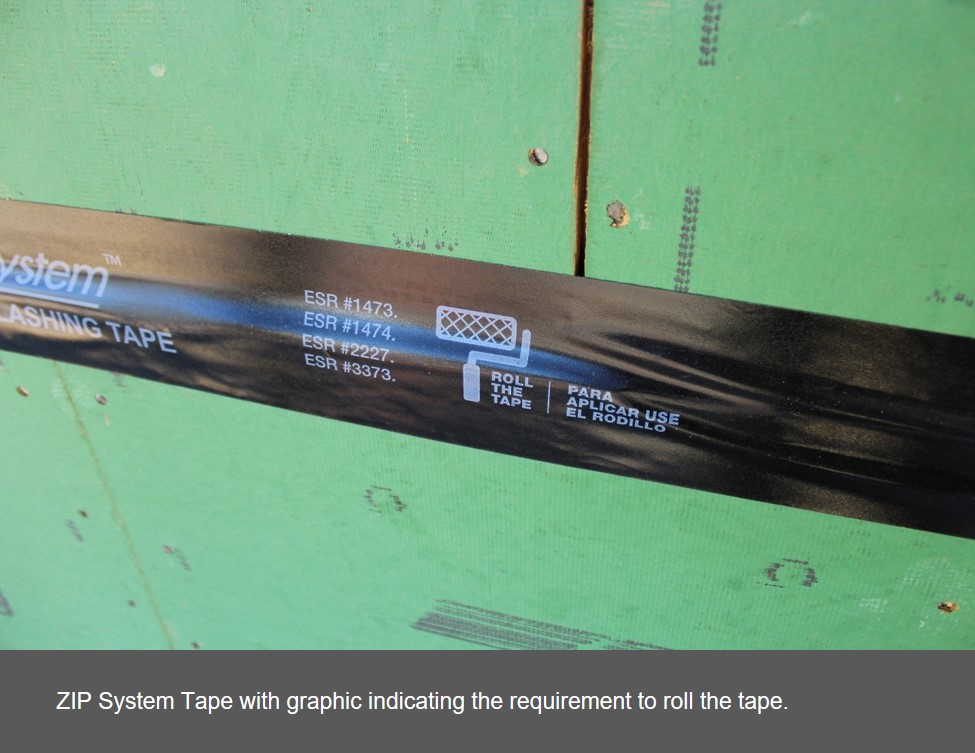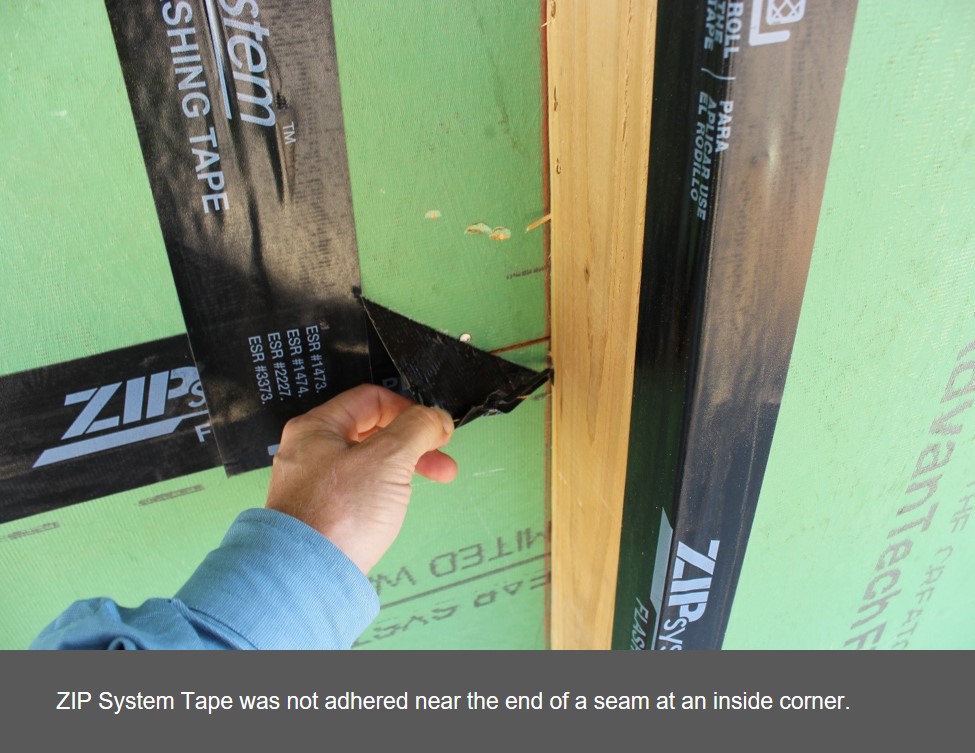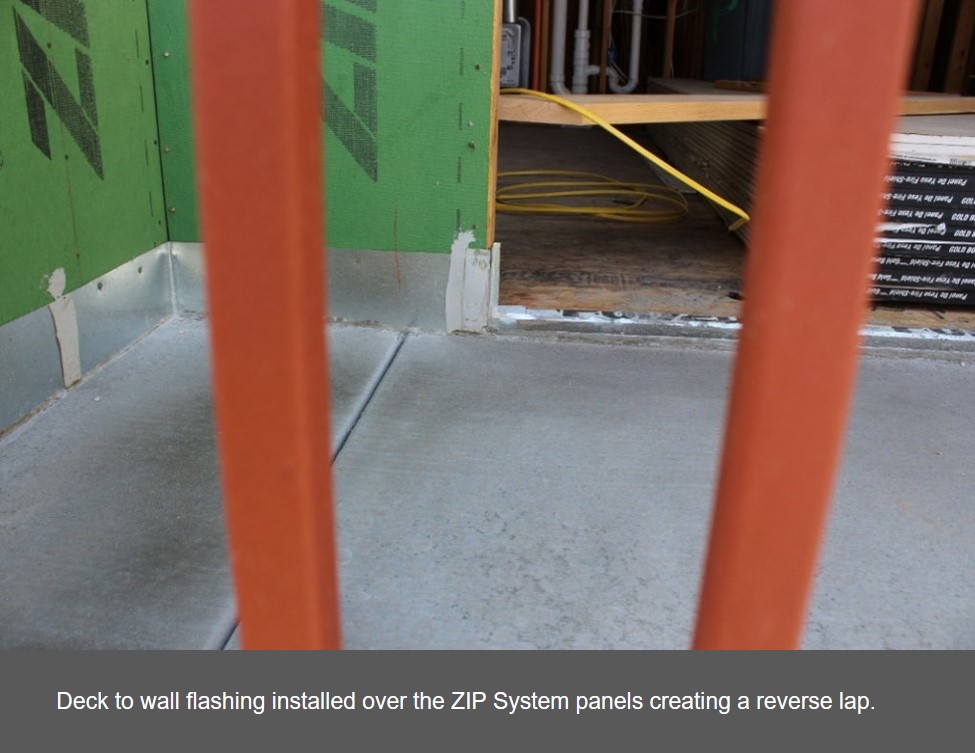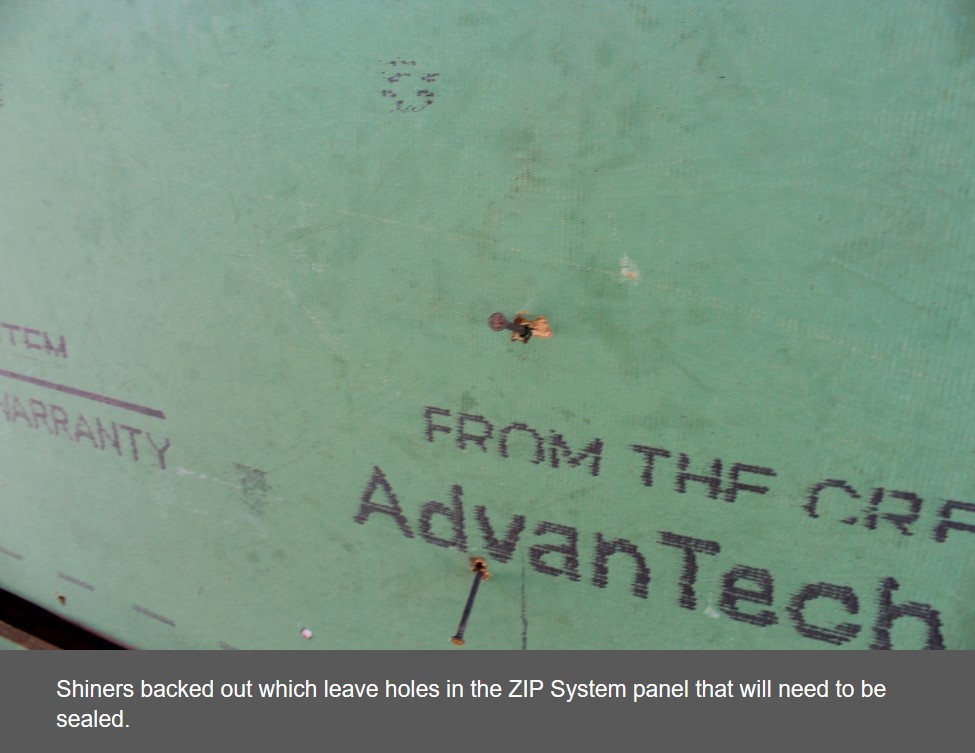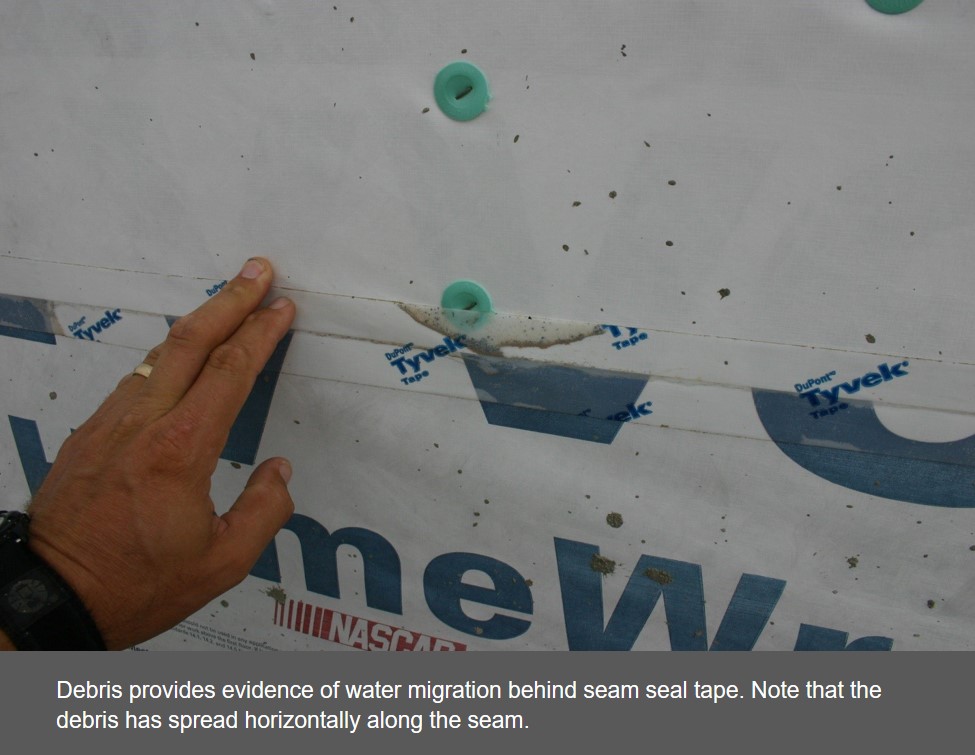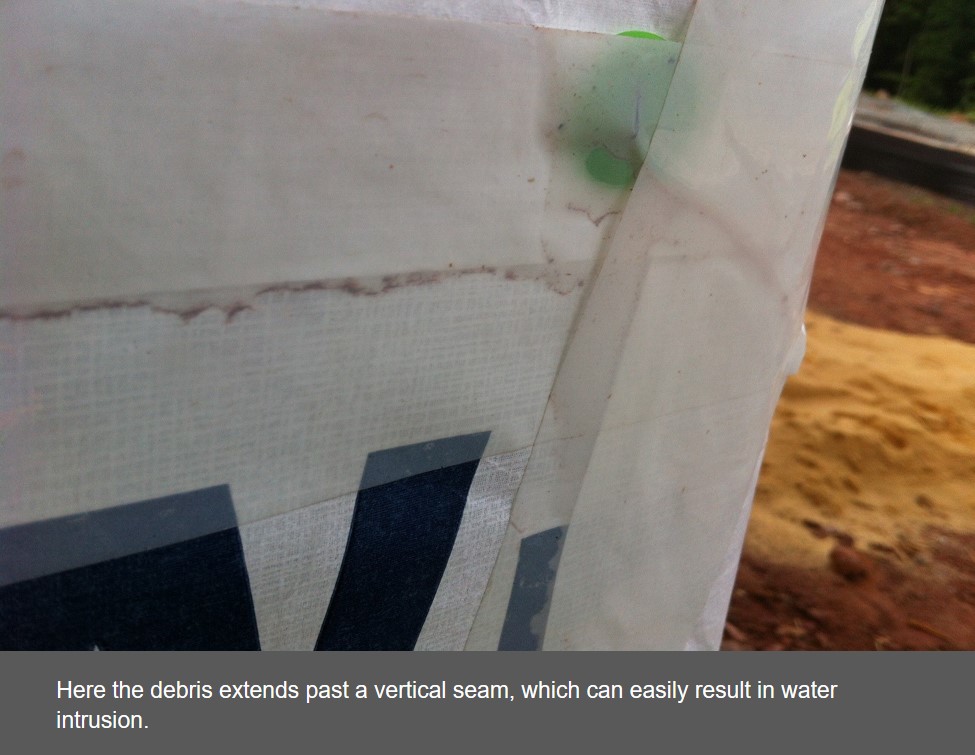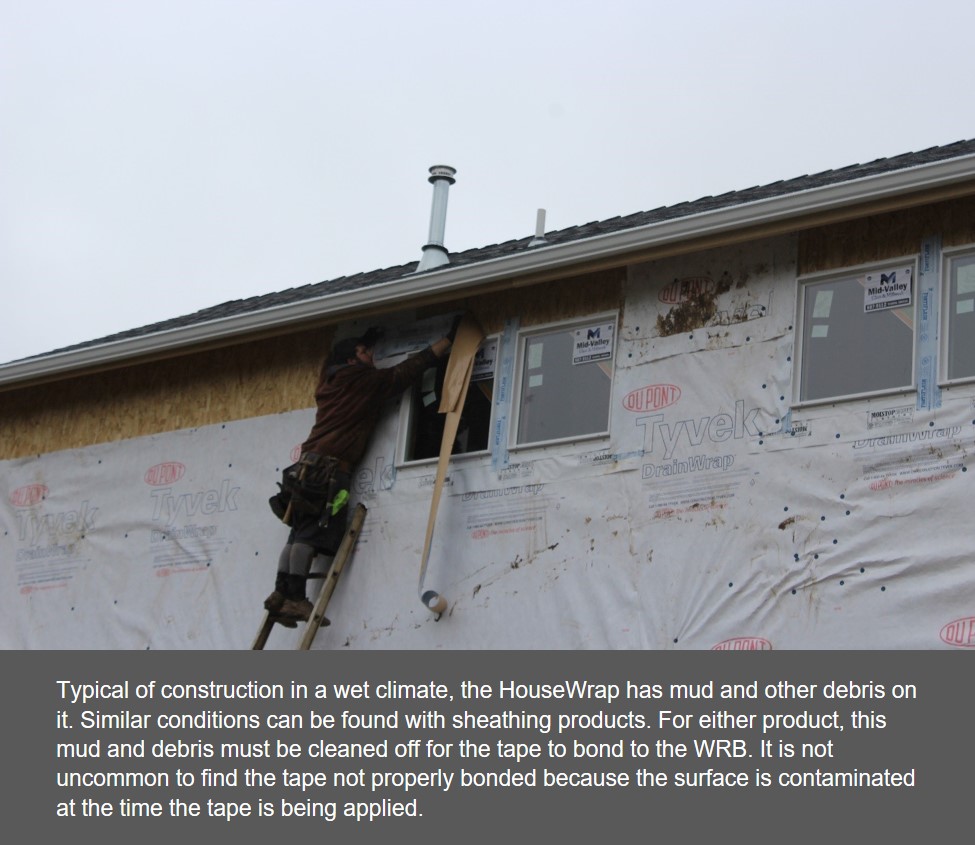By: Jeff Hoch, Principal Architect & Mark Crawford, Senior Risk Assessment Consultant
Quality Built, LLC (QB) is the nation’s leader in third-party QA inspections and risk management solutions for new building construction. Our Field Consultants average over 20 years of experience in the industry and comprise of architects, engineers and licensed inspectors. Through our Tech Alert articles, our objective is to capture the knowledge of our employees to educate the building industry on trending anomalies found nationwide, critical material incompatibility issues, building best practices, code, installation tips, consequences of poor building practices, technology-driven risk mitigation solutions, building sciences, and more.
In this article, we will be providing an update on our original pros and cons article published in 2016 that compared the ZIP System® developed by Huber Engineered Woods, LLC to the HomeWrap® system, manufactured by DupontTM Tyvek®. The purpose of this article is to provide an unbiased comparison of these leading weather-resistive barrier (WRB) systems while uncovering the latest updates to each of these competing products and their corresponding manufacturer specifications.
The WRB Serves A Critical Function in Building Construction
The WRB is an element of the building envelope, which works to protect the building from the penetration of elements such as air, water, heat, light and noise. If not installed correctly, the consequences can result in significant damages. One of the most common outcomes of faulty installation of the WRB is water intrusion. Water intrusion is the biggest generator of construction defect claims and insurance losses in construction. Although the ZIP System and HomeWrap are the most commonly used products seen on the projects we inspect across the nation, they are not the only WRB products available on the market. The products you select should best support your structure in terms of regional building code, the knowledge of the installers, material compatibility, construction phasing, weather conditions and more.
Product Descriptions
Huber ZIP System Description
ZIP System panels are manufactured by Huber Engineered Woods, LLC. The ZIP System assembly includes multiple components: the ZIP System Sheathing Panels, Tape, the updated Roller, and the new Liquid Flash product. The sheathing panels are made of OSB wood structural panels with an exterior facer of medium density phenolic-impregnated polymer-modified material. This facer qualifies as a Type 1 WRB. The panels come in three thicknesses: 7/16 inch, 1/2 inch, and 5/8 inch thick. Each panel thickness can be used interchangeably in roof sheathing or wall sheathing applications. The green-colored ZIP System panels are 7/16-inch-thick while the 1/2-inch, and 5/8-inch thick panels come in a sienna color. Huber also offers ZIP System R-Sheathing (insulated panels with R3, R6, R9 or R12 rating).
The ZIP System Tape comes in two varieties: Flashing Tape and Stretch Tape. Both securely bond to many substrates using pressure-sensitive acrylic adhesive with a backing material. Huber’s latest Liquid Flash product is a silyl-terminated-polyether liquid-applied flashing material. The ZIP System Roller has now been designed to emboss a pattern into the ZIP System Tape when sufficient pressure has been applied.
DuPont Tyvek HomeWrap Description
HomeWrap is manufactured by E.I. DuPont De Nemours & Company, Inc. (DuPont™) DuPont Building Innovations. HomeWrap is described as white, spun-bonded olefin that combines fibers of high-density polyethylene into a sheet product. These sheets are nonwoven and nonperforated and are made by the material being flash spunbonded using heat and pressure to create sheets of various sizes. The product is equivalent to a Grade-D 60-minute WRB. In addition to HomeWrap, the Tyvek line includes flashing and sealant materials as well as other grades of weather and air barrier sheet products including:
- DuPont™ Tyvek® CommercialWrap®
- DuPont™ Tyvek® ThermaWrap® LE
- DuPont™ Tyvek® CommercialWrap® D
- DuPont™ Tyvek® DrainVent™ Rainscreen
- DuPont™ Tyvek® Fluid Applied WB+™
- DuPont™ Tyvek® Protec™ Roofing Underlayment
- DuPont™ Adhesive Primer
- DuPont™ FlexWrap™ EZ
- DuPont™ FlexWrap™ NF
- DuPont™ Flashing Tape
- DuPont™ StraightFlash™
- DuPont™ StraightFlash™ VF
- DuPont™ Tyvek® Fluid Applied Flashing & Joint Compound+
- DuPont™ Sealant for Tyvek® Fluid Applied System
- DuPont™ Tyvek® Residential Wrap Caps
- DuPont™ Tyvek® Commercial Wrap Caps
- DuPont™ Door & Window Foam
Pros: ZIP System vs. HomeWrap
Huber ZIP System - Pros
1. Quick Installation
ZIP System panels have the WRB layer factory-laminated to the OSB panel substrate. This integrated system is able to save time in installing fully sheathed exterior walls by eliminating the need for sheet-applied WRBs. ZIP System panels are available in long lengths, allowing for vertical wall panel installation. Penetrations are sealed with a flashing tape or liquid flash which contributes to the quick installation.
2. Not as Susceptible to Wind Damage While Awaiting Cladding Installation
During high wind events, we see damage to traditional WRB papers, synthetic house wraps and roofing products, including completed roofs. The ZIP System WRB is less susceptible to wind damage since it is bonded directly to the wood sheathing in the factory. The integrated ZIP System panel has more uplift resistance and tear resistance than other competing products. This is an important factor to consider (especially in areas prone to high wind conditions), as construction practices often result in the cladding installation being delayed for several days to weeks following the WRB and roof felt installations.
3. Updated ZIP System Roller
This specialized tool now embosses the tape when enough pressure has been applied to properly adhere the tape to the substrate. This provides a visual reassurance that the installer has used the roller and applied sufficient pressure to the product. Tyvek HomeWrap also calls for the use of a roller to ensure proper adhesion; however, since the tape is clear and does not have a thickness to it, the product is not able to benefit from the embossment feature.
4. Tape Alternative - ZIP System Liquid Flash
ZIP System Liquid Flash provides an alternative to the ZIP System Tape at seams and penetrations. This product reduces the risk of leaks from improperly taped joints and penetrations, especially at horizontal joints. Liquid Flash simplifies the flashing of circular or irregular shaped penetrations. The product also has a thickness verification standard that is easy to follow, i.e. proper thickness is achieved when the substrate is no longer visible.
5. Thirty-Year Warranty
The ZIP System offers a 30-year warranty which is three times longer than the ten-year warranty offered by Tyvek for their HomeWrap product. However, there are contingencies that can make the warranty unable to be transferred. See the “Huber ZIP System - Cons” section below for more information.
Tyvek HomeWrap - Pros
1. Can Be Applied Over Open Studs
Since HomeWrap is a flexible rolled sheet product, similar to traditional building papers, it can be installed over open stud framing and sheathing. In some parts of the country, it is standard to sheath the entire exterior. However, in many areas, that is not the standard practice. Tyvek’s installation methods can save material cost in these circumstances.
2. Seams Are Lapped, Not Butted
HomeWrap installs similar to traditional 60-minute building paper with overlaps at seams. While improper taping can pose problems, as discussed in the “Tyvek HomeWrap - Cons” section below, the installation calls for a six-inch overlap that can help protect the structure from water intrusion.
3. Window Heads and Other Similar Conditions Are Lapped in a Weatherboard Manner
Several years ago, Tyvek revised their installation instructions and details to provide a weatherboard lap at window heads and similar conditions to address the risk of water intrusion. This was not the case when the product was first introduced, at which case the instructions and details called for the HomeWrap to wrap into the window opening, followed by the window being installed and taped on all sides.
4. Vapor Permeable
The Tyvek Wrap products are vapor permeable at 54 perms, allowing the building walls to dry quicker than ZIP Sheathing, which is permeable at 16 perms. Given the fact that this function is not directionally controlled by the product, care in the wall design should be taken, which is discussed in greater detail in the “Tyvek HomeWrap - Cons” section below.
5. Repairs Are Easy
Depending on the size of the damage, repairs can be as simple as installing Tyvek tape over the hole, rip or tear. Larger repairs would call for an additional piece of Tyvek HomeWrap to be taped over the damaged area.
Cons: ZIP System vs. HomeWrap
Huber ZIP System - Cons
1. Sheathing Panels are Butted and Taped, Creating a Reverse Lap
When properly installed, the ZIP System can provide an effective weather and air barrier. However, we often see issues in the field related to the installation of the tape that poses the threat of water intrusion. The ZIP System Tape is required to be applied to clean, dry surfaces that are free of dirt, dust and frost. Contact of the adhesive surface of the tape with any foreign matter that may affect the bond must also be avoided. Both the air temperature, as well as the temperature of the sheathing must be at or above 20°F at the time of tape installation. The ZIP System Roller should be used to address wrinkles, referred to as “fish-mouths” or “bird-mouths” to ensure proper adhesion of the tape to avoid water intrusion. Tape that is not properly adhered due to these circumstances can void the warranty.
The most concerning of these issues is improper tape installation at the horizontal joints where the tape creates a reverse lap. While the reverse lap is a concern for both the Huber ZIP System Sheathing and Tyvek HomeWrap, the ZIP System Sheathing lacks the six-inch overlap of protection that HomeWrap calls for (See Tyvek HomeWrap - Pros section above for more information). The ZIP System Sheathing panels are, by design, butted against each other, providing a 1/8-inch gap between each panel. While this gap helps to address expansion, the opening presents a concern for water intrusion when not taped correctly.
When the installer uses the ZIP System Roller or Liquid Flash product, the above concerns are significantly minimized. In either case, the bond of the product is less likely to be an issue if the substrate is clean and the temperature is within the manufacturer’s allowable range during installation.
2. Flashing of Penetrations Using the ZIP System Tape
The most common flashing method observed in the field is using the ZIP System Tape to flash penetrating items including windows, doors, and mechanical vents. This method raises the same concerns as indicated above for taped horizontal joints by creating a reverse lap at the head of every penetration. The proper installation of the tape can provide a water-resistive condition; however, we often find issues with the tape application.
3. Time Savings Can Be Regional
Installation time can be accelerated when open stud framing is combined with areas of sheathing. However, this approach is only common in specific regions. The installation could be more time consuming and costly if the structural design does not call for fully-sheathed exterior walls. In order to use the ZIP System as the WRB for the entire building, all exterior walls must be sheathed, including gable ends, etc.
4. Fastener Recommendation Confusion
Huber indicates that code-approved fasteners for structural panels are acceptable and that corrosion-resistant fasteners are to be used only: where required by code, required by the building official, or when the building is subject to saltwater spray adjacent to a coastline. Many other products that are used as a sheet-applied WRB or products attached over the WRB require corrosion-resistant fasteners. Additionally, all flashings installed at the WRB are required to be corrosion-resistant. For more information on the corrosion of metal, take a look at our Tech Alert, Corrosion of Metal Connectors in Coastal Regions.
5. Larger Repairs Require Framing
Holes in the ZIP System Sheathing that are too large to be repaired with tape (or covered by sheet-applied WRBs) must be repaired by cutting out the damaged area and replacing it with a sizable piece of ZIP System Sheathing. Blocking must then be installed to support the patch. In the case of shear wall assemblies, the blocking must allow edge nailing of the patch and the existing panel to match the shear wall schedule. Minor repairs such as damage caused by over-driven fasteners can be addressed using Huber’s ZIP System Tape or Liquid Flash.
6. Non-Transferable Warranty
The ZIP System products’ limited warranty is for the sole benefit of the original property owner and is not transferable. In some cases, the original property owner may not be the original occupant, particularly in multi-family buildings.
Tyvek HomeWrap - Cons
1. Can Be Damaged by Wind
It is not uncommon for the exterior cladding and final HomeWrap fasteners to be installed several weeks following the initial installation of the HomeWrap. This type of delay makes the HomeWrap susceptible to being blown off or damaged due to high wind exposure - thus exposing the structure to water intrusion. Additionally, as work progresses on the interior of the structure following the HomeWrap installation and prior to the cladding installation, the potential for other building products to be damaged increases.
2. Is A Second Step Beyond Sheathing
For areas of the structure that call for sheathing on the exterior walls, the installation of HomeWrap is a second step that must occur after the sheathing is installed. In some cases, this is inspected by the local jurisdiction for compliance with the braced wall plans and schedules. This additional step prolongs the construction process in contrast to that of the time savings provided by the Huber ZIP System that has the WRB already applied to the sheathing.
3. May Have a Reverse Lap When Used as an Air Barrier
The ZIP System is not the only system to incorporate a reverse lap. Many house wraps that will function as both a weather-resistive barrier and air barrier incorporate a reverse lap. This occurs when the horizontal seams are taped to reduce air leakage. One important distinction between Huber’s ZIP System and Tyvek’s HomeWrap is that HomeWrap is required to have six inches of overlap (top layer over bottom layer) in a weatherboard fashion. Although this does not prevent water from penetrating the structure due to a bad tape joint, it does have the ability to reduce this risk to some degree. See our Tech Alert on Seam Seal Tape for more information on issues related to reverse laps.
4. Requires Proprietary Fasteners
Although other fasteners are available, Tyvek recommends the use of their proprietary fasteners that include a Wrap Cap for installation of their HomeWrap. Use of other fasteners may void the warranty if they do not provide the proper seal at the fastener and spread the fastener load over a larger area. Our QB Field Consultants often observe installers utilizing slap staplers (as opposed to DuPont Tyvek Wrap Cap Staples) that cause damage to the membrane and must be repaired.
5. Ten-Year Limited Warranty
Tyvek’s 10-year limited warranty is transferable regardless of if the builder or contractor goes out of business. However, this is significantly less in comparison to the potential 30 years that the Huber ZIP System offers.
Final Thoughts
Testing has proven that both the ZIP System and HomeWrap system can provide an effective air and weather barrier when properly installed. However, despite both manufacturers providing detailed installation instructions, we find various instances of both products being installed improperly and not per the instructions out in the field. It is one thing for a product to pass laboratory testing, and an entirely different thing to have it pass in the field when installed under field conditions. In our inspections performed nationwide of these and similar WRB products, there a number of trending anomalies that we often see. They include:
- Holes, rips, tears and damage to WRB.
- Tape being installed over contaminated surfaces or at temperatures either above or below the allowable range.
- Installers failing to use a roller to properly adhere the tape, increasing the risk of water intrusion.
- Tape often possessing wrinkles, creating “fish-mouths” or “bird-mouths” that can catch water and may result in water intrusion into the structure.
Quality Built does not manufacture or own the ZIP System or HomeWrap products and does not hold favoritism of one product over the other. There are also other quality WRB products available on the market. A builder’s decision on which product to use should be based off of what would best support their structure in terms of regional building code, the knowledge of the installers, material compatibility, construction phasing, weather conditions and more. To know for certain, we recommend consulting with Building Envelope Experts such as QB, your insurance provider and a lawyer to address material compatibility, coverage and warranty limitations.
Once the WRB product that best suits your circumstance is selected, it is advised that builders retain a knowledgeable third-party QA company such as Quality Built to perform a Technical Plan ReviewTM to identify conflicts between products, details and the product manufacturer’s installation instructions while providing insights for building best practices; QA inspections to document the observation and correction of anomalies; and Forensic Quality Control Testing to ensure that the product is functioning as intended and can withstand exposure to the elements such as water and air.
There is one common issue that is plaguing the construction industry. How do we effectively train and verify compliance when dealing with a decentralized workforce that also experiences high employee turnover? Quality Built has developed the Genesis Training & Learning Management SystemTM to tie microburst training modules to our proprietary inspection checkpoints embedded in our QB Builder Link® data collection app and automated reports to effectively educate inspectors, superintendents and installers. These training modules include photos and videos, quizzes, direct references to applicable building code and manufacturer specifications, and installation tips outlining acceptable and unacceptable installation practices and the consequences of poor installation. Regardless of the product you decide to use, Quality Built can provide you with comprehensive training modules that can be referenced where it is needed most – during installation out on the field. For more information on Genesis, contact [email protected].
Photo Examples
Huber ZIP System
Tyvek HomeWrap
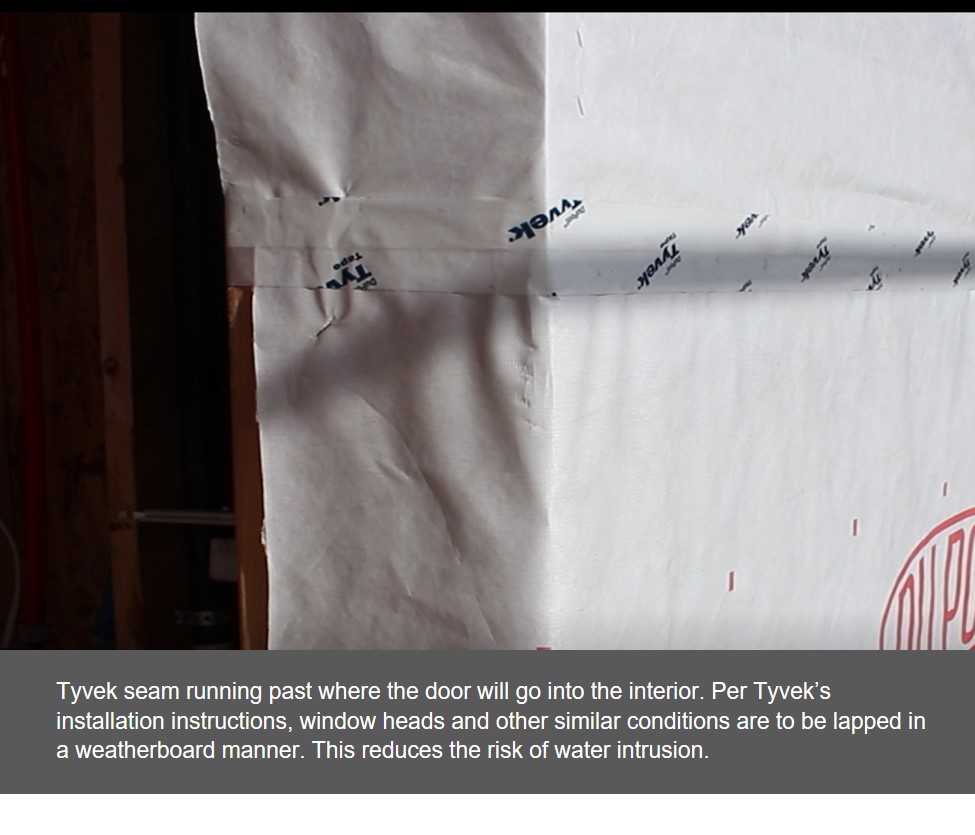 About the Authors
About the Authors
Jeff Hoch, Principal Architect
Jeff is a licensed architect and has been involved in the construction industry for over 27 years. He has a passion for safety and strives to educate the industry about building best practices and risk mitigation techniques. Jeff is constantly taking part in educational seminars and is extremely knowledgeable when it comes to building code requirements. Jeff performs inspections all across the nation and specializes in forensic inspections, AAMA/ASTM water testing, technical peer plan reviews, quality assurance, and much more. He also is extremely experienced with design standards, local ordinances, forensic building failure analysis, and construction defects. You can reach Jeff at [email protected].
Mark Crawford, Senior Risk Assessment Consultant
Mark is a seasoned Project Manager and Quality Assurance Consultant with over 20 years of expertise in the construction industry. Mark has professionally designed and managed vertical construction and civil improvement projects throughout the United States. He has in-depth knowledge in civil engineering and architecture, along with extensive experience in building inspections, building codes, design standards, local ordinances, forensic building failure analysis, construction defects and expert witness testimony. You can reach Mark at [email protected].
References:
